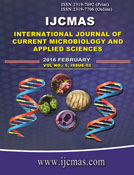


 National Academy of Agricultural Sciences (NAAS)
National Academy of Agricultural Sciences (NAAS)

|
PRINT ISSN : 2319-7692
Online ISSN : 2319-7706 Issues : 12 per year Publisher : Excellent Publishers Email : editorijcmas@gmail.com / submit@ijcmas.com Editor-in-chief: Dr.M.Prakash Index Copernicus ICV 2018: 95.39 NAAS RATING 2020: 5.38 |
Plant–bacterial interactions in the rhizosphere are the determinants of plant health and soil fertility. These are associated with the rhizosphere, which is an important soil ecological environment for plant–microbe interactions. Plant growth promoting rhizobacteria (PGPR) are considered to promote plant growth directly or indirectly. PGPR can exhibit a variety of characteristics responsible for influencing plant growth. The exact mechanisms by which PGPR promote plant growth are not fully understood, but are thought to include (i) the ability to produce or change the concentration of plant growth regulators like indoleacetic acid, gibberellic acid, cytokinins and ethylene (Arshad and Frankenberger, 1993; Glick, 1995), (ii) asymbiotic N2 fixation (Boddey and Dobereiner, 1995), (iii) antagonism against phytopathogenic microorganisms by production of siderophores (Scher and Baker, 1982), antibiotics (Shanahan et al., 1992) and cyanide (Flaishman et al., 1996), (iv) solubilization of mineral phosphates and other nutrients (De-Freitas et al., 1997; Gaur, 1990). Another mechanism by which PGPR can inhibit fungal cell wall degrading enzymes, e.g., chitinase and ß-1,3-glucanase.Biological control of soil-borne plant pathogens and the synthesis of antibiotics have also been reported in several bacterial species. This review begins with describing how the bacteria help plant directly and indirecty to producing hydohytic enzyme, hormone, cyanide and sidrophore.
 |
 |
 |
 |
 |